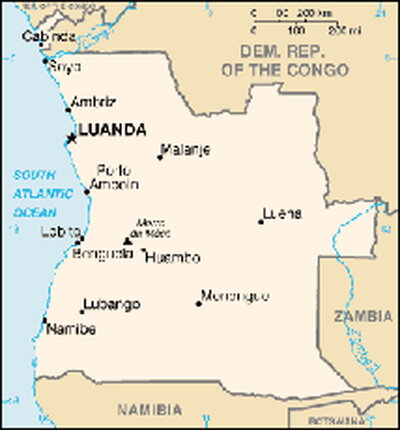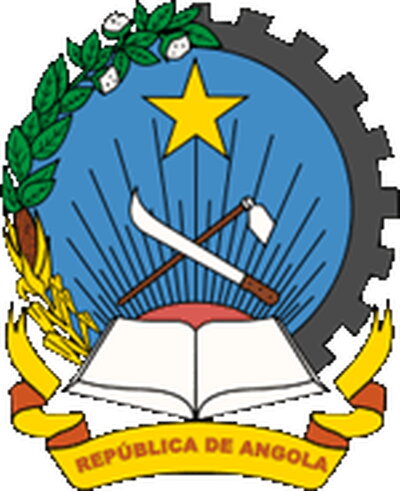

Region: Southern Africa
Quick Facts:
- Population: 12.5 million
- Capital: Luanda
- Total Area: 481,350 sq miles
- Major Languages: Portuguese (official), Bantu and other African languages Life Expectancy: 55.34 years (men), 58.09 years (women)
- Literacy: 67.4%
- Monetary unit: Kwanza (AOA)
- Exchange Rate:$1= 76.6 kwanza (AOA) (2007),
- Income (GDP) per capita: $7,800 (2007 est.)
- Paved roads: 10.3% of total roads
- Electric Power Consumption (per capita): 0.2528 kWh (2006 est.)
- Mobile phone subscribers: 19 per 100 people
- Internet Users: 5.8 per 1,000 people
- Internet Domain: .ao
- Country Code: +244
- Time Difference: GMT +1(7 hours ahead of Illinois during Standard Time)
- Climate: semiarid in south and along coast to Luanda; north has cool, dry season (May to October) and hot, rainy season (November to April
- Type of Government: republic; multiparty presidential regime chief of state: President Jose Eduardo DOS SANTOS (since 21 September 1979)
Possible Travel Warning: Please check the list of current travel warnings
Historical and Socio-Political Background:
Angola is rebuilding its country after the end of a 27-year civil war in 2002. Fighting between the Popular Movement for the Liberation of Angola (MPLA), led by Jose Eduardo DOS SANTOS, and the National Union for the Total Independence of Angola (UNITA), led by Jonas SAVIMBI, followed independence from Portugal in 1975.
A single party system operated from independence in 1975, and restrictions on parties other than the ruling MPLA were lifted only in 1991. Legislative elections and the first round of presidential elections followed in 1992. Before the second round of presidential elections could take place Jonas Savimbi withdrew his Unita movement from the process and war resumed. An uneasy peace was established by the Lusaka Accords of 1994, but a Government of Unity and National Reconciliation (GURN) was created only in April 1997. At the end of August 1997 the MPLA decided to exclude Unita from the GURN over its failure to comply fully with the terms of the Lusaka Accords. Unita’s 70 parliamentarians were then excluded from the National Assembly. Subsequently a small part of the Unita leadership in Luanda declared that it was deposing Savimbi from the party presidency. The MPLA government then declared that it would negotiate with this “Renovated Unita”, a step that gained some backing from the OAU, despite misgivings at the UN.
The fall of Mobutu in Zaire and Pascal Lissouba in Congo-Brazzaville signalled the removal of two of Savimbi’s staunchest regional backers and emboldened Luanda to lift the formal ban on Unita, which it now recognized as the official opposition. Attempts were also made to revive the GURN, and a number of Unita members were appointed to governorships and cabinet positions. Unita’s failure to respect its undertakings in terms of the Lusaka peace accords led to a gradual resumption of hostilities by the end of 1998.
Up to 1.5 million lives may have been lost - and 4 million people displaced - in the quarter century of fighting. SAVIMBI's death in 2002 ended UNITA's insurgency and strengthened the MPLA's hold on power. President DOS SANTOS has announced legislative elections will be held in September 2008, with presidential elections planned for sometime in 2009.
The adult prevalence rate of HIV/AIDS in Angola is 3.9 percent of the population, and 21,000 HIV/AIDS deaths were estimated at 81 000 in 2007. There is also a very high risk of major infectious diseases, including hepatitis A, diarrhea, and malaria.
Economy:
Angola's high growth rate is driven by its oil sector. Oil production and its supporting activities contribute about 85% of GDP. Increased oil production supported growth averaging more than 15% per year from 2004 to 2007. A postwar reconstruction boom and resettlement of displaced persons has led to high rates of growth in construction and agriculture as well. Much of the country's infrastructure is still damaged or undeveloped from the 27-year-long civil war. Remnants of the conflict such as widespread land mines still mar the countryside even though an apparently durable peace was established after the death of rebel leader Jonas SAVIMBI in February 2002. Subsistence agriculture provides the main livelihood for most of the people, but half of the country's food must still be imported.
In 2005, the government started using a $2 billion line of credit, since increased to $7 billion, from China to rebuild Angola's public infrastructure, and several large-scale projects were completed in 2006. Angola also has large credit lines from Brazil, Portugal, Germany, Spain, and the EU. The central bank in 2003 implemented an exchange rate stabilization program using foreign exchange reserves to buy kwanzas out of circulation. This policy became more sustainable in 2005 because of strong oil export earnings; it has significantly reduced inflation. Although consumer inflation declined from 325% in 2000 to under 13% in 2007, the stabilization policy has put pressure on international net liquidity. Angola became a member of OPEC in late 2006 and in late 2007 was assigned a production quota of 1.9 million barrels a day, somewhat less than the 2-2.5 million bbl Angola's government had wanted. To fully take advantage of its rich national resources - gold, diamonds, extensive forests, Atlantic fisheries, and large oil deposits - Angola will need to implement government reforms, increase transparency, and reduce corruption. The government has rejected a formal IMF monitored program, although it continues Article IV consultations and ad hoc cooperation. Corruption, especially in the extractive sectors, and the negative effects of large inflows of foreign exchange, are major challenges facing Angola
Before independence in 1975 Angola had a diversified and prosperous economy, though it was characterized by huge inequalities. The main agricultural exports, coffee, sisal and cotton, were produced on European dominated commercial farms, the mining sector was strong, producing diamonds, iron ore and oil, and there was a relatively large and diverse manufacturing sector. Today, after more than 25 years of nearly continuous warfare, the Angolan economy is in disarray and per capita output among the worlds lowest. In fact, for the last three decades, what was once a diversified economy has been gradually destroyed as a consequence of almost uninterrupted war as well as bad policy choices at central level that have resulted in escalating macro-economic instability. According to the EIU, Angola has 2.1% of real GDP growth and a consumer price annual inflation of 325%.
Subsistence agriculture provides the main livelihood for 85% of the population, many of whom are now facing threats of growing food insecurity as cereal production has declined to an all time low. In 1999 agriculture accounted for a mere 7% of GDP. The oil sector, mostly offshore and insulated from the war, has boomed and is now vital to the economy, contributing about 61% to GDP (1999) and producing 90% of exports. Angola is currently the seventh largest exporter of petroleum to the USA.
Manufacturing contributed 3.5 per cent of GDP in 1999. Production is centred on food processing, brewing, sugar, textiles and tobacco products. Also important are light manufacture, electrical goods (eg radio production), construction materials, steel production, motor vehicles, detergents, bicycles and chemicals. Activity is concentrated in Luanda, Lobito and Huambo. Output has been sluggish due to shortages of foreign exchange, poor management and a low-paid labour force. About 60 per cent of total production is accounted for by nationalised industries. The government has embarked upon a privatisation programme involving some 200 state-owned enterprises in a variety of industrial sectors.The industrial sector grew 5.2 per cent in 1998, down from 8.1 per cent in 1997. Manufacturing declined from 8 per cent in 1997 to -10 per cent in 1998.
Trade Information:
- Exports: $45.03 billion f.o.b. (2007 est.)
- Exports - commodities: crude oil, diamonds, refined petroleum products, gas, coffee, sisal, fish and fish products, timber, cotton
- Exports - partners: US 32.1%, China 32%, France 5.9%, Taiwan 5.3%, South Africa 4.5% (2007)
- Imports: $12.29 billion f.o.b. (2007 est.)
- Imports - commodities: machinery and electrical equipment, vehicles and spare parts; medicines, food, textiles, military goods
- Imports - partners: Portugal 19.7%, US 10.9%, China 10.5%, Brazil 10.3%, South Africa 6.6%, France 6.3%, UK 4.6%, Germany 4.3% (2007)
Resources for Businesses:
Embassy of Angola in the United States of America
2100-2108 16th Street, NW
Washington, DC 20009
Phone: 202.785.1156
FAX: 202.822.9049
e-mail: angola@angola.org

Angola Area Chamber of Commerce
Last updated on 09/23/2009